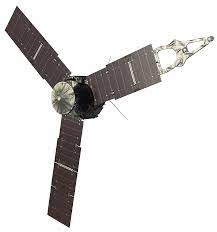Juno Spacecraft : NASA

The National Aeronautics and Space Administration’s (NASA) Juno mission completed its 53rd close flyby of Jupiter, sped past the gas giant’s volcanic Moon Io, and captured a stunning frame of both of them together.
- JUNO is an acronym for Jupiter’s Near-Polar Orbiter.
- It was launched in 2011; the Juno spacecraft initially embarked on a 5-year journey to the largest planet in our solar system.
- The spacecraft’s objectives evolved, and it transitioned into a full Jupiter system explorer with flybys of Jovian moons.
- Goal is to understand the origin and evolution of Jupiter, look for a solid planetary core, map the magnetic field, measure water and ammonia in the deep atmosphere, and observe auroras.
Moon Io:
- Io is the most volcanically active world in the solar system, and it has hundreds of volcanoes that often erupt with molten lava and sulphurous gases.
- It is slightly larger than the Earth’s Moon and has a diameter that is about one-quarter that of our planet.
- It is tidally locked to Jupiter, meaning that one side of the Moon always faces the planet.
- It takes around 1.8 Earth days to both rotate on its axis and revolve once around Jupiter.




